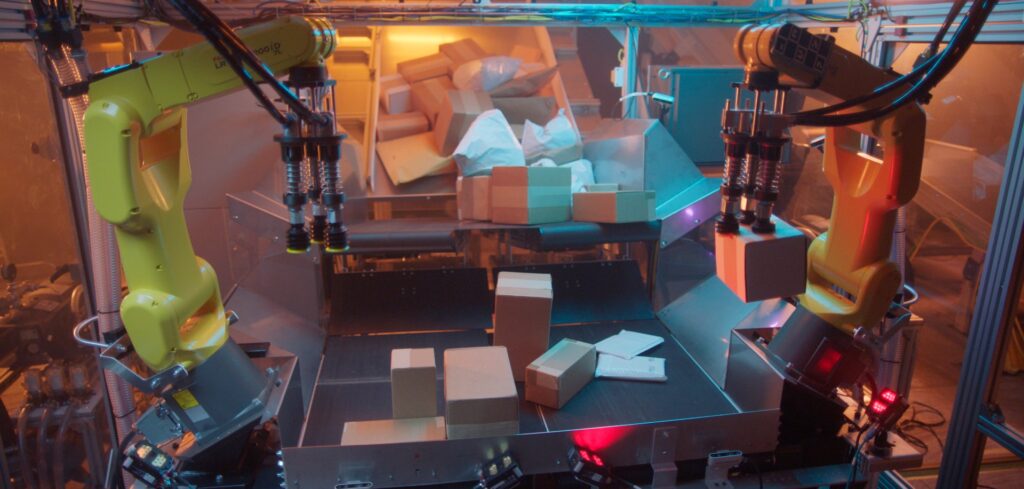Modern technology has given today’s consumers an insatiable desire to shop online. According to Statista, by 2026, the volume of small parcels processed each year is expected to reach 266 billion – more than double the volume of 2020. Compound that volume increase with the consumer’s expectation to receive those packages within two to three days, and it’s clear the package, fulfillment, logistics and delivery industry will need to evolve rapidly to thrive.
Integrating artificial intelligence (AI) and machine learning (ML) capabilities can transform warehouse and fulfillment operations exponentially. For example:
- Robots that use AI and ML to learn as they work and improve performance over time drive increased throughput and efficiency.
- AI-derived data provide companies with real-time information that supports quick decision-making.
- The collaboration between AI-powered robotics and employees can triple productivity while mitigating workforce shortages.
- AI is financially approachable and generates return-on-investment almost immediately with the availability of new business models like Robots as a Service (RaaS).
If logistics and supply chain managers aren’t already looking at how to integrate AI solutions, it is likely that their C-suite leaders will soon be asking them to. According to the 2021 Gartner CEO Survey, CEOs predict AI will have the greatest impact on industry during the next three years. They expect to double or triple the application of AI in their organizations in areas such as customer fulfillment, quality and planning.
Moreover, AI drives profit. The McKinsey Global Institute estimates that corporations that are early adopters of AI can potentially double their cash flow and gain three times more economic benefits from AI than late adopters.
AI advantages in distribution and fulfillment centers
In general terms, AI refers to a computer’s ability to perform tasks that normally require human intelligence, such as visual identification, discernment and decision-making. Today AI is being paired with robotics, and machine and vision learning software, to automate the small parcel induction process. Parcel, post and e-commerce companies can now use people-powered staffing teams alongside AI-enabled robotic systems to alleviate capacity shortages and increase efficiency – a critical need for e-commerce supply chains at this pivotal time.
AI-robotics can also be used as an autonomous induction solution to streamline operations or during high-capacity times that are undesirable for workers, like during the peak holiday season. As organizations utilize automated solutions for repetitive tasks like sortation and induction, they can re-allocate their limited human resources to more valuable assignments.
With human-like intelligence, an AI-powered induction workcell utilizes vision, grasping and manipulation algorithms to methodically work through the non-stop avalanche of parcels coming down the chutes. Cameras in the workcell see, maneuver and read barcodes to sort packages efficiently. These highly intelligent robotic systems address the common challenges of parcel induction, such as variations in size, weight, fragility and material, to handle each parcel with the precise grip and speed required to accurately place it on the moving sorter.
With each repeated task, AI-powered robots learn – becoming smarter, faster, more accurate and more efficient. As they improve, so do the operations that employ them. AI-enabled induction robots can process up to 2,000 units per hour (UPH) while maintaining a 99.5% uptime with the support of remote robot pilots.
Smarter, real-time decisions driven by AI-generated data
The need for speed is critical in parcel and post operations. So is the need for data. AI-powered induction robots also deliver on that front, providing robust business analytics that operators can leverage to make faster, smarter business decisions in real time. As robots go about their tasks, they capture and evaluate millions of datapoints across a range of metrics, including:
- Throughput: How many units robots process.
- Speed: How fast the robot processes items.
- Accuracy: The accuracy rate when sorting items and orders.
The supply chain team can leverage this information to drive continuous improvements throughout operations. AI-enabled robots allow operators to access analytics in real time, without having to pull information manually, for instant insights.
New business models and tangible KPIs
Flexible and approachable financing options have negated the need to make upfront capital investments in robotics. Replaced with subscription-style service models, called RaaS, that enable return-on-investment nearly immediately, operators pay only for the work the robots execute. Using the RaaS model, supply chain teams can better align costs with fluctuations in volume and demand.
AI-powered induction robots are already producing tangible business outcomes for logistics, e-commerce, distribution and fulfillment operations – even as they face soaring demand, supply chain challenges and labor shortages. The early adopters who most effectively employ AI technology will likely navigate the package tsunami ahead and maintain high levels of customer satisfaction, gaining a competitive advantage in their markets.


